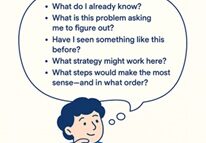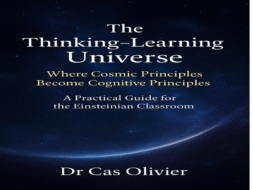How Pre-Thinking Builds Clarity, Confidence, and Cognitive Strength
Walk into any maths classroom and you’ll likely see this:
A learner is given a sum. They stare at it. Then they dive straight into solving—often by copying the last method they remember. They might get partway through. They might even get the answer right. But ask them to explain their thinking, and the response is shaky at best. They even struggle with meaning of words and language overall.
They’ve solved the sum, but they haven’t owned it.
In mathematics, success isn’t just about getting the answer—it’s about knowing how to think before solving even begins.
That’s why we need to teach learners to plan the plan.
It is not following the steps, it is about planning the plan for the steps.
What Does It Mean to “Plan the Plan”?
“Planning the plan” is the process of teaching learners to pause before diving in—to orient themselves cognitively, assess what they know, and decide how they’ll approach the problem. It is intentional mental preparation.
This builds:
- Awareness
- Confidence
- Cognitive clarity
- And eventually, self-regulated thinking
Instead of repeating someone else’s steps, the learner begins to construct a thinking strategy of their own.
The Role of Working Memory in the Exam
When a learner sees a maths problem in a test or exam, the working memory takes control.
Working memory acts like a temporary workspace—it juggles information, holds values, and attempts to organise logic on the fly.
But here’s the problem:
Working memory has a limited capacity and under exam pressure, it becomes fragile.
If the learner hasn’t already processed and structured the problem mentally, working memory becomes flooded:
- Steps are mixed up
- The learner forgets what the question is asking
- Cognitive overload sets in
- Panic replaces clarity
The result? A promising learner appears unprepared—not because they didn’t study, but because they didn’t pre-structure their thinking.
By planning ahead—even mentally—the learner frees working memory to focus on logical flow instead of basic recall.
Planning Before Solving: The Learner’s Internal Dialogue
Before beginning any problem, learners should be asking:
- What do I already know?
- What is this problem asking me to figure out?
- Have I seen something like this before?
- What strategy might work here?
- What steps would make the most sense—and in what order?
This kind of pre-thinking may only take 30 seconds, but the effect is transformational.
It builds the foundation for ownership, agency, and strategic clarity.
This is the moment where the learner stops performing maths and starts thinking mathematically.
Planning to Strategize: From Response to Intention
Once the learner has gathered what they know and mentally framed the problem, they’re ready to build a strategy.
Strategizing isn’t about remembering the correct formula.
It’s about:
- Choosing a path based on the context, not the last example
- Adapting to new information if needed
- Deciding how to represent and test their thinking
This process turns passive learners into flexible problem-solvers.
They begin to say:
“I know what I’m going to try—and why.”
This not only improves performance on assessments—it prepares them for the kind of real-world thinking maths is meant to develop.
Why This Matters
When learners skip planning, they rely entirely on memory.
And when memory fails, so does the learner.
But when learners plan the plan and plan to strategize:
- They slow down their thinking—on purpose
- They build clarity before confusion sets in
- They adapt more easily when something unfamiliar arises
- They shift from mimicry to mastery
- They protect their working memory from cognitive overload
This is how confident thinkers are developed—not by drilling procedures, but by cultivating cognitive habits of mind.
Final Thought: Teach the Thinking, Not Just the Method
Too often in maths, we focus on “what to do” and skip “how to think.”
But lasting learning doesn’t come from following someone else’s steps.
It comes from learning to build your own approach—one problem at a time.
It’s not about finding the answer.
It’s about knowing where to begin, and having a clear strategy to think it through.
If we want learners to succeed in maths and beyond, we must stop teaching them to simply solve problems…
And start teaching them to plan their thinking before solving even begins.?





